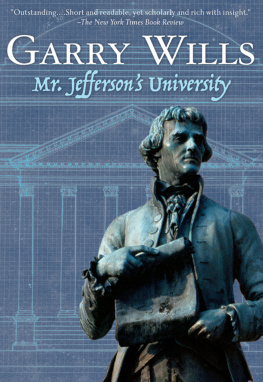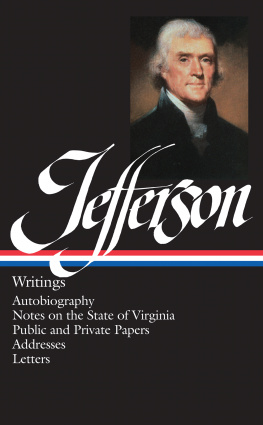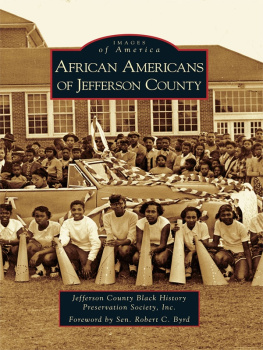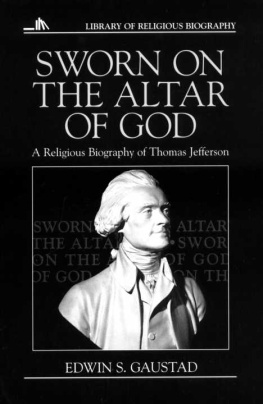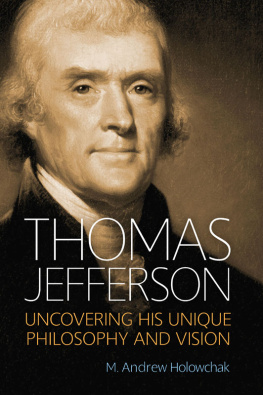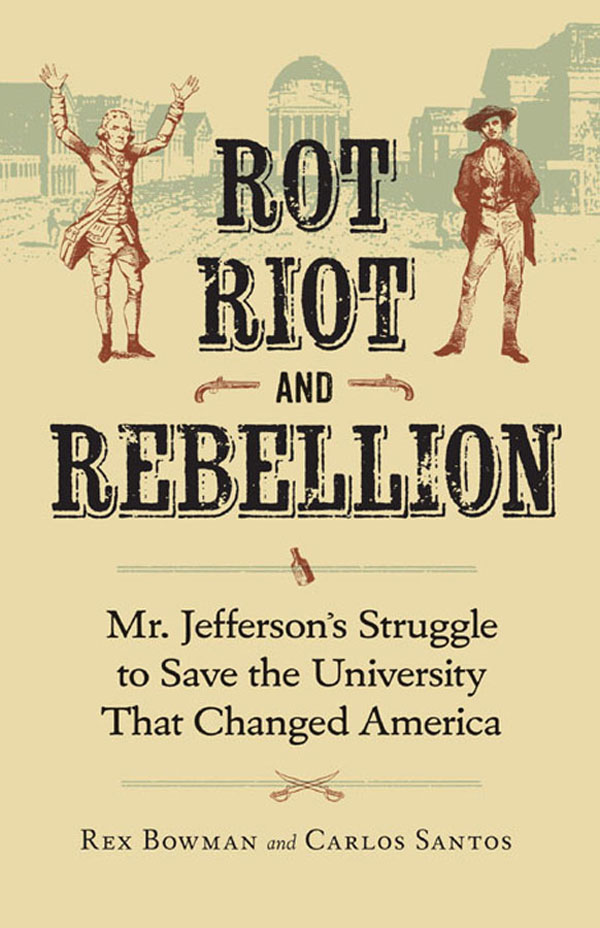ROT, RIOT, AND REBELLION
ROT, RIOT,
AND
REBELLION

Mr. Jeffersons Struggle
to Save the University
That Changed America

R EX B OWMAN and C ARLOS S ANTOS
University of Virginia Press London and Charlottesville
University of Virginia Press
2013 by the Rector and Visitors of the University of Virginia
All rights reserved
Printed in the United States of America on acid-free paper
First published 2013
1 3 5 7 9 8 6 4 2
L IBRARY OF C ONGRESS C ATALOGING-IN -P UBLICATION D ATA
Bowman, Rex.
Rot, riot, and rebellion : Mr. Jeffersons struggle to save the university that changed America / Rex Bowman and Carlos Santos.
pages cm
Includes bibliographical references and index.
ISBN 978-0-8139-3470-9 (cloth : alk. paper) ISBN 978-0-8139-3471-6 (e-book)
1. University of VirginiaHistory. 2. Jefferson, Thomas, 1743-1826Influence.
3. Universities and collegesUnited StatesHistory. I. Title.
LD 5678. B 68 2013
378.009755481dc23
2012049804
To our families
B. J. Hendrickson Santos, Michael, Katie, Sarah, and Jaiden
and Jennifer Bowman, Cody, and Carey
The Southerner asks concerning any man, How does he fight?
The Northerner asks, What can he do?
R ALPH W ALDO E MERSON
C ONTENTS

Introduction
The University of Virginia is one of the nations top public universities. Its alumni, known as the Wahoos, would say its not one of the bestits the best. The school annually tops collegiate rankings, routinely produces captains of industry, and turns out top-notch scholars the way lesser schools crank out football champions. The universitys endowment stands at an incredible $5 billion. Nearly two centuries after its creation, its success now seems preordainedits founder, after all, was the American genius Thomas Jefferson. But his schoola radical experiment that would lay the groundwork for fundamental and dramatic changes in American higher educationalmost failed.
During the universitys first twenty years, its leaders struggled to keep it open. The school was often broke, and Jeffersons enemies, crouched and ready to pounce, constantly looked for reasons to close its doors. The university, his critics said, was godless, catered to the rich, and was built in the wrong placein a poor old turned out field in backwater Charlottesville. And most important, its first students, though few in number, turned Jeffersons vision of an orderly academical village into an early incarnation of an ugly Wild West town.
Although some students came to learn, many came to lark and laze. These students of the first two decades, often the spoiled, self-indulgent scions of southern plantation owners, sometimes the sons of prosperous merchants, led a life of dissipation. With a sense of honor easily bruised, they were reflexively violent. The wrong word, the wrong look could easily lead to a scuffle, if not a duel. Calling a young man a puppyinnocuous by todays standardscould get one shot. Cursing in the presence of a lady could lead to a whipping. The students brandished guns freely, sometimes shooting in the air, sometimes at each other. They secreted dirks and daggers and, with little to no thought and even less hesitation, stabbed each other. They pummeled, kicked, bit, and gouged each other. They brawled with town merchants, they scuffled with the local wagoners. They cheated at cards for money. They robbed graves. They gambled on cockfights. They beat slaves. They cursed each other, townsfolk, and professors. They vandalized property (even taking a hatchet to the front doors of the Rotunda, the universitys signature building) and mutilated cows. They drank and drank and drank. And rioted.
Their wrongdoing would have kept a modern city police department busy, but this was the mayhem of a tiny student body that averaged fewer than two hundred students per year. (In its first year, 1825, the school enrolled 125 students; in the following years, 177, 128, 131, 120, 133, 133, 140, 158; and in the tenth year, 205.) Modern readers cant fully appreciate early students behavior and the agony it caused Jefferson because even eyewitness accountscouched in the polite language of the eraprovide only a glimpse of the universitys raw beginnings. As the historian J. H. Powell noted, The historian can never construct a record of events. All he can do is construct a record of records. Still, the depth of the students depravity astonishes us today.
Professors occasionally armed themselves, and with good reason. One professor was horsewhipped. Others were attacked in their classrooms. One was a target of a bombtwice. Student William H. Hall of Harpers Ferry, Virginia, surreptitiously set an ink bottle packed with gunpowder on Professor George Tuckers windowsill. Hall had corked the bottle, inserted a hollow quill through the cork, and run a fuse through the quill to the gunpowder. He lit it, but it failed to explode. His second bomb also failed to go off. Hall was expelled. His perplexed father wrote and demanded further investigation, noting in his sons defense that the boy had just been expelled from Harvard College for the same offense. It seems extremely improbable that he should have so soon repeated a bombing attempt, the father argued with logic muddled by love.
But such vicious acts were not uncommon in the schools early years, and sometimes student behavior escalated beyond viciousness to full-blown rioting. The school endured at least a half dozen riots in its first twenty years. Hundreds of militiamen were called in to quell one of them. In a strange twist, the students celebration on the anniversary of one riot led to the murder of a professor. The disturbances damaged the schools reputation, threatened the universitys future, and jeopardized critical financial support from the state legislature.
There was also the usual schoolboy mischief. Students smoked each other out of their rooms, rolled flaming tar barrels between the dormitories, sang filthy songs learned from plantation slaves, and pounded drums after midnight to annoy and awaken tired professors and fellow students. In one instance, the rowdy revelers explained the noise was only for the purpose of serenading. The professors, however, already on edge from the casual violence, had little patience for even harmless tomfoolery.
Violence in the United States universities was all too common during the republics early years. In schools both of the North and the South, students looked for excuses to smash furniture, break glass, and resist authority. Students often seemed glad to escalate confrontations with professors into riots. What made the mayhem at the University of Virginia unique was the stakes; the school was new and experimental, unsure of the publics support and uncertain of its own future. No powerful church denomination backed the university, no well-connected alumni group stood ready to come to its defense. Its leaders understood that student drunkenness, violence, and rebellion could result in the universitys ruin, so they acted as if, in the publics mind, the school were on a probationary period, a period during which Virginias leaders would decide if they would continue to support this new kind of university on the American landscape.


